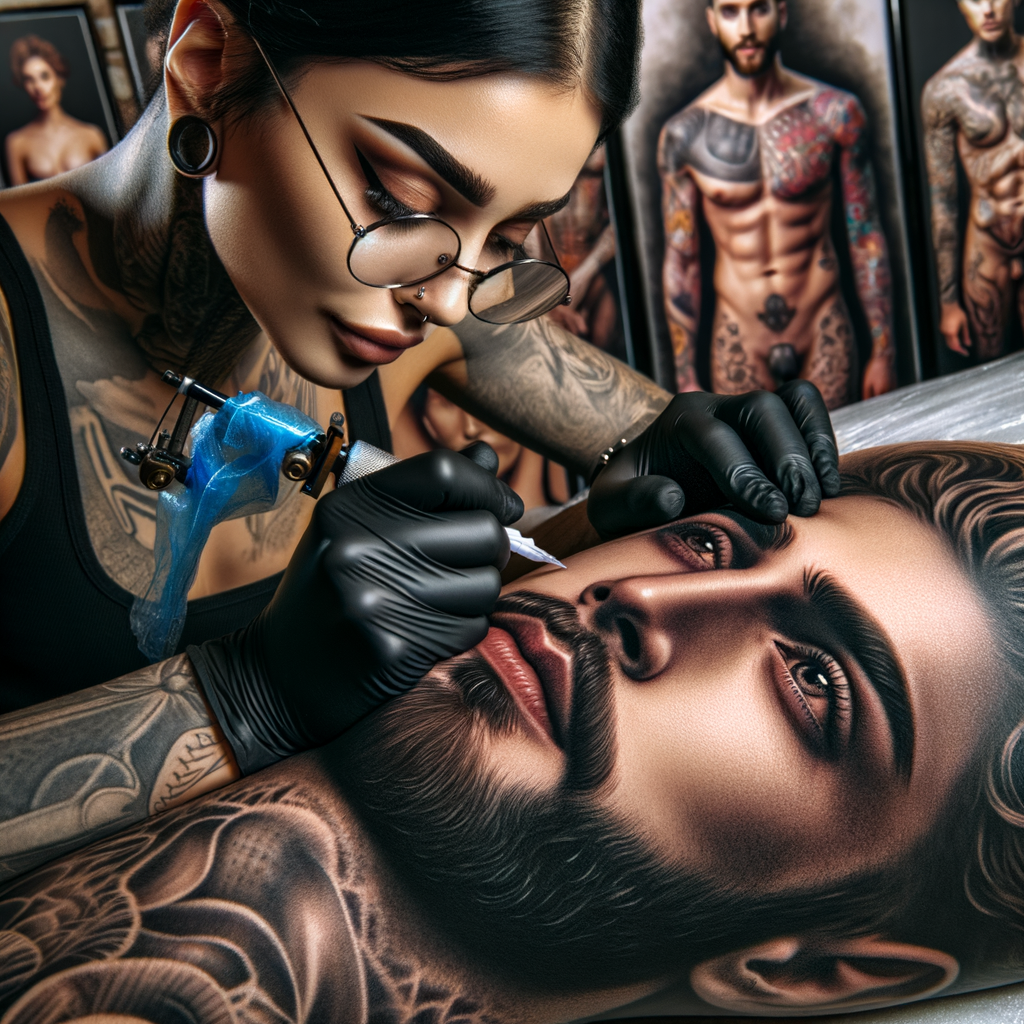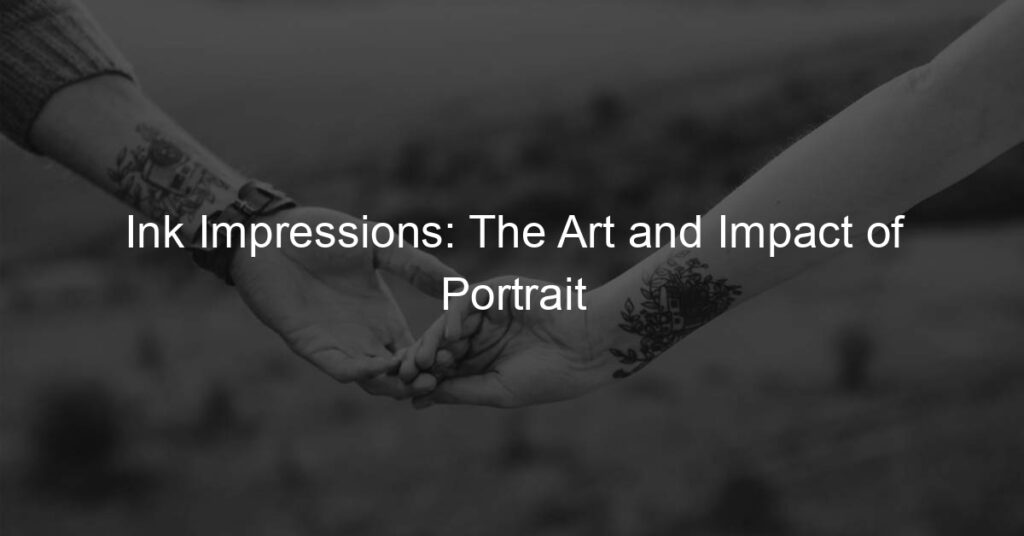
Introduction to Portrait Tattoos
Portrait tattoos are a unique form of self-expression and a testament to the power of art. This introductory section will delve into the definition and history of portrait tattoos, as well as the power they hold in the world of tattoo art.
- Definition and brief history of portrait tattoos
A portrait tattoo is a type of tattoo that replicates a person’s face or likeness onto the skin. The art of portrait tattoos dates back to the 19th century when sailors would get tattoos of their loved ones as a keepsake during their long voyages. Over the years, the art form has evolved, with artists now able to create incredibly detailed and lifelike tattoos that capture the essence of the person being portrayed.
- The power of portraits in tattoo art
Portrait tattoos hold a significant power in the world of tattoo art. They serve as a permanent tribute to someone important in the wearer’s life, whether it’s a family member, a friend, or a celebrity. The power of a portrait tattoo lies in its ability to evoke strong emotions and memories. It’s not just about the physical likeness, but also about capturing the spirit and personality of the person. This makes each portrait tattoo unique and deeply personal.
As we delve deeper into the world of portrait tattoos, we will explore different designs, tattooing techniques, and case studies of tattoo artist portraits. We will also provide tips and tricks for tattooing faces and conclude with the impact of portrait tattoos. Stay tuned to learn more about this fascinating art form.
Exploring Portrait Tattoo Designs
Portrait tattoos are a unique way to express your personality, interests, or pay tribute to someone you admire. In this section, we will delve into the fascinating world of face tattoo designs. We’ll explore popular designs and discuss the differences between realistic and abstract styles.
Face Tattoo Ideas
Face tattoos are a bold choice, often chosen to represent a significant person or idea. Let’s explore some popular face tattoo designs and the differences between realistic and abstract styles.
- Popular face tattoo designs
- Realistic face tattoos vs. abstract designs
Popular face tattoo designs often depict famous personalities, loved ones, or fictional characters. Some people choose to get the faces of their favorite musicians, actors, or historical figures. Others may choose a face that represents a particular concept or idea, such as a skull to symbolize mortality or a lion to represent courage.
Realistic face tattoos aim to capture the exact likeness of the person or character being depicted. This style requires a high level of skill and precision from the tattoo artist. On the other hand, abstract face designs use shapes, lines, and colors to create a more stylized or symbolic representation. The choice between realistic and abstract designs often comes down to personal preference and the message you want your tattoo to convey.
In conclusion, face tattoos offer a wide range of design possibilities. Whether you prefer the lifelike detail of realistic designs or the creative freedom of abstract styles, there’s a face tattoo out there that’s perfect for you.
Body Figure Tattoos
Body figure tattoos are a unique form of self-expression that has gained popularity over the years. They are a way to celebrate the human form in all its glory. Let’s delve into the appeal of these tattoos and explore some examples.
- Understanding the Appeal of Human Figure Tattoos
- Examples of Body Figure Tattoo Designs
- Realistic Portraits: These tattoos aim to capture the likeness of a person in as much detail as possible. They can be of loved ones, celebrities, or historical figures.
- Abstract Figures: These designs take a more artistic approach, using shapes and lines to represent the human form.
- Symbolic Figures: These tattoos use the human form to represent certain concepts or ideas, such as strength, love, or freedom.
Human figure tattoos are more than just ink on skin. They are a reflection of personal stories, emotions, and experiences. The appeal lies in their ability to capture the essence of human life in a permanent form. They allow individuals to express their admiration for certain figures, remember loved ones, or simply appreciate the beauty of the human form.
They are also a testament to the skill of the tattoo artist, who must capture the intricacies of the human body with precision and creativity. The level of detail required in these tattoos is a testament to the artist’s skill and dedication.
There are numerous designs available when it comes to body figure tattoos. Here are a few examples:
Choosing a design depends on personal preference and the message one wants to convey. It’s important to work closely with a skilled tattoo artist to ensure the final result aligns with your vision.
In conclusion, body figure tattoos are a beautiful way to celebrate the human form and express personal stories. They require a high level of skill from the artist and can range from realistic portraits to abstract or symbolic representations. The appeal of these tattoos lies in their ability to capture the essence of human life in a permanent form, making them a popular choice for many.
Tattooing Techniques for Portraits
When it comes to creating stunning portrait tattoos, mastering certain techniques is key. In this section, we will explore realistic tattooing techniques that can help you achieve lifelike results.
Realistic Tattooing Techniques
Realistic tattoos aim to replicate the intricate details of a person’s face. This requires a deep understanding of shading and color blending. Let’s delve into these techniques:
- Shading Techniques for Realistic Face Tattoos
- Color Blending for Skin Tones
Shading is a crucial part of creating a realistic tattoo. It adds depth and dimension, making the tattoo appear three-dimensional. The key to effective shading is understanding light and shadow. You need to identify the light source and shade accordingly. Darker shades represent areas with less light, while lighter shades indicate areas directly hit by the light. Practice is essential to mastering this technique.
Color blending is another vital technique for realistic tattoos. It involves mixing different colors to achieve the perfect skin tone. Start with a base color, then add small amounts of other colors until you reach the desired shade. Remember, everyone’s skin tone is unique, so you’ll need to adjust your color blend for each tattoo. It’s also important to consider how colors will look once they’ve healed, as they can change slightly over time.
In conclusion, mastering shading and color blending techniques can significantly enhance the realism of your portrait tattoos. Practice these techniques regularly to improve your skills and create stunning, lifelike tattoos.
Abstract Tattooing Techniques
Abstract tattooing is a unique art form that allows for a wide range of creativity and personal expression. Let’s explore two key techniques used in abstract tattooing: line work and color blocking.
- Using line work in abstract figure tattoos
Line work is a fundamental aspect of abstract tattooing. It involves the use of lines to create shapes and patterns that don’t necessarily represent real-world objects, but instead evoke emotions or concepts. This technique is often used in abstract figure tattoos, where the human form is depicted in a non-realistic, stylized manner.
For example, an abstract figure tattoo might use bold, jagged lines to represent a sense of chaos or conflict, or smooth, flowing lines to convey a sense of peace and harmony. The choice of line work can dramatically affect the overall mood and meaning of the tattoo.
- Color blocking in abstract designs
Color blocking is another popular technique in abstract tattooing. This involves using large, solid areas of color to create contrast and visual interest. In abstract designs, color blocking can be used to highlight certain elements of the design, or to create a bold, striking effect.
For instance, an abstract tattoo might use a bright, vibrant color block to draw attention to a particular part of the design, or a series of contrasting color blocks to create a dynamic, eye-catching pattern. The use of color blocking can add depth and dimension to an abstract tattoo, making it truly stand out.
| Technique | Description | Example Use |
|---|---|---|
| Line work | Using lines to create shapes and patterns | Depicting human form in a non-realistic manner |
| Color blocking | Using large, solid areas of color | Creating contrast and visual interest in a design |
In conclusion, abstract tattooing techniques like line work and color blocking offer a wealth of possibilities for creative expression. Whether you’re a tattoo artist looking to expand your skills, or a tattoo enthusiast seeking a unique and personal design, understanding these techniques can open up a whole new world of artistic potential.
Case Studies: Tattoo Artist Portraits
Let’s take a look at two talented tattoo artists who have made a name for themselves in the world of portrait tattoos. Each artist has a unique style and specialization, contributing to the rich diversity of this art form.
- Artist 1: Specialization in Realistic Face Tattoos
Our first artist is renowned for their exceptional ability to create realistic face tattoos. This artist’s work is characterized by a high level of detail and a deep understanding of facial anatomy. They are able to capture the unique features and expressions of each individual, resulting in a tattoo that is not only a portrait but a true representation of the person.
The artist’s technique involves careful shading and precise line work. They use a variety of needle sizes to achieve different effects, from the fine lines needed for facial features to the broader strokes used for shading. This artist’s work is a testament to the power of portrait tattoos to capture and convey the human spirit.
- Artist 2: Unique Style in Body Figure Tattoos
The second artist we’re featuring has a unique style in body figure tattoos. Their work is characterized by a bold, graphic style that combines traditional tattooing techniques with modern design elements. This artist’s body figure tattoos are distinctive and instantly recognizable, often featuring stylized representations of the human form.
What sets this artist apart is their ability to use the body’s natural curves and contours to enhance their designs. They consider the placement and orientation of the tattoo as integral parts of the design process. This attention to detail results in tattoos that are not only visually striking but also harmonious with the body they adorn.
Both of these artists demonstrate the incredible range and potential of portrait tattoos. Whether it’s a hyper-realistic face or a stylized body figure, these tattoos are a powerful form of self-expression and a testament to the skill and creativity of the artists who create them.
Tips and Tricks for Tattooing Faces
When it comes to tattooing faces, there are a few key tips and tricks that can make a big difference in the final result. Let’s explore two of the most important aspects: understanding facial proportions and creating depth and dimension in face tattoos.
- Understanding Facial Proportions
Understanding facial proportions is crucial when tattooing faces. The human face is divided into thirds, from the forehead to the eyebrows, from the eyebrows to the nose, and from the nose to the chin. These proportions need to be accurately represented in the tattoo to achieve a realistic look.
For example, the eyes are usually situated in the middle of the face, and the distance between them is typically the same as the width of one eye. Getting these proportions right can make a significant difference in the overall appearance of the tattoo.
- Creating Depth and Dimension in Face Tattoos
Creating depth and dimension in face tattoos is another essential skill. This can be achieved by using different shades and tones to create the illusion of depth. For instance, darker shades can be used to represent areas of the face that are further away or in shadow, while lighter shades can be used for areas that are closer or in light.
It’s also important to consider the shape and contours of the face. For example, the nose and cheeks are typically more prominent, while the eyes and mouth are more recessed. By accurately representing these features, you can create a tattoo that truly captures the depth and dimension of the face.
In conclusion, understanding facial proportions and creating depth and dimension are two key skills for tattooing faces. By mastering these techniques, you can create stunning and realistic face tattoos that truly capture the likeness of the subject.
Conclusion: The Impact of Portrait Tattoos
As we reach the end of our journey exploring portrait tattoos, it’s clear that these unique pieces of body art hold a significant place in both personal and societal contexts. Let’s delve into these impacts a little deeper.
- The personal significance of portrait tattoos
Portrait tattoos are more than just ink on skin. They’re a deeply personal expression of identity, love, and remembrance. For many, a portrait tattoo is a tribute to someone special, a way to keep a loved one close or to honor a hero or idol. It’s a form of storytelling, a way to carry a piece of personal history or a cherished memory.
For example, a mother may get a portrait tattoo of her child, a symbol of her unending love and devotion. Or, a music lover might get a portrait tattoo of their favorite musician, a testament to the inspiration and joy that artist has brought into their life.
- The societal impact and acceptance of face and figure tattoos
In the past, tattoos were often associated with rebellion and counterculture. However, societal views have shifted dramatically over the years. Today, tattoos, including portrait tattoos, are widely accepted and even celebrated as a form of personal expression and art.
Portrait tattoos, in particular, have played a significant role in this shift. They’ve helped to challenge the stereotype of tattoos as mere adornments or symbols of rebellion. Instead, they’ve highlighted the potential of tattoos as meaningful, deeply personal expressions of identity and tribute.
Moreover, the rise of social media has allowed tattoo artists and enthusiasts to share their work and stories with a global audience, further contributing to the acceptance and appreciation of portrait tattoos.
In conclusion, portrait tattoos have a profound impact, both on a personal level and in society at large. They’re a powerful form of self-expression and a testament to the beauty and diversity of human stories and experiences.






